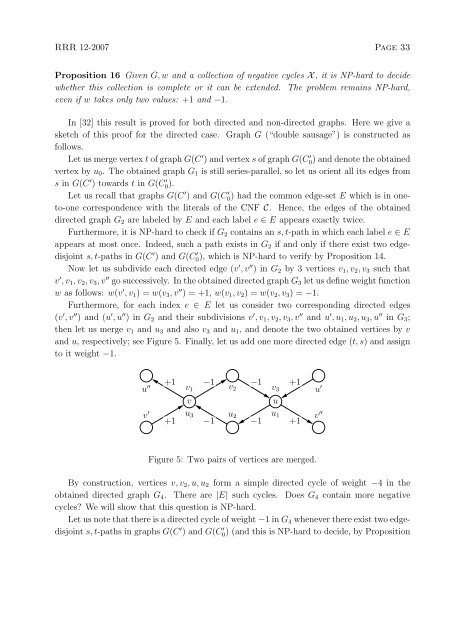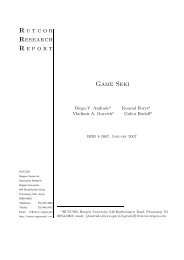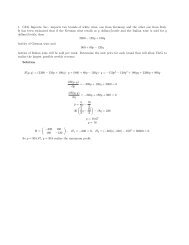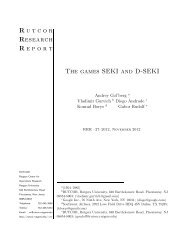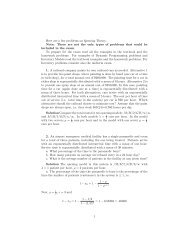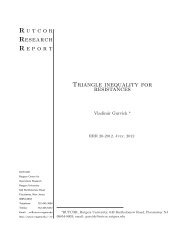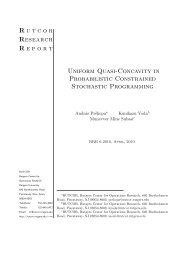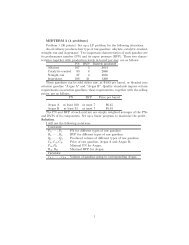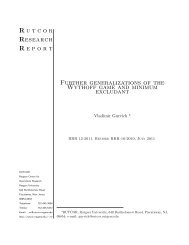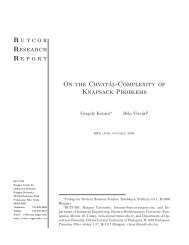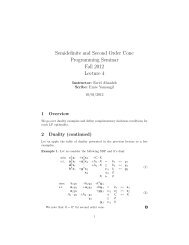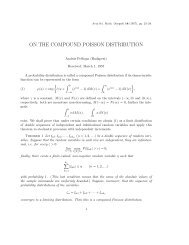Generating vertices of polyhedra and related monotone ... - Rutcor
Generating vertices of polyhedra and related monotone ... - Rutcor
Generating vertices of polyhedra and related monotone ... - Rutcor
You also want an ePaper? Increase the reach of your titles
YUMPU automatically turns print PDFs into web optimized ePapers that Google loves.
RRR 12-2007 Page 33Proposition 16 Given G,w <strong>and</strong> a collection <strong>of</strong> negative cycles X, it is NP-hard to decidewhether this collection is complete or it can be extended. The problem remains NP-hard,even if w takes only two values: +1 <strong>and</strong> −1.In [32] this result is proved for both directed <strong>and</strong> non-directed graphs. Here we give asketch <strong>of</strong> this pro<strong>of</strong> for the directed case. Graph G (“double sausage”) is constructed asfollows.Let us merge vertex t <strong>of</strong> graph G(C ′ ) <strong>and</strong> vertex s <strong>of</strong> graph G(C ′ 0) <strong>and</strong> denote the obtainedvertex by u 0 . The obtained graph G 1 is still series-parallel, so let us orient all its edges froms in G(C ′ ) towards t in G(C ′ 0).Let us recall that graphs G(C ′ ) <strong>and</strong> G(C ′ 0) had the common edge-set E which is in oneto-onecorrespondence with the literals <strong>of</strong> the CNF C. Hence, the edges <strong>of</strong> the obtaineddirected graph G 2 are labeled by E <strong>and</strong> each label e ∈ E appears exactly twice.Furthermore, it is NP-hard to check if G 2 contains an s,t-path in which each label e ∈ Eappears at most once. Indeed, such a path exists in G 2 if <strong>and</strong> only if there exist two edgedisjoints,t-paths in G(C ′ ) <strong>and</strong> G(C ′ 0), which is NP-hard to verify by Proposition 14.Now let us subdivide each directed edge (v ′ ,v ′′ ) in G 2 by 3 <strong>vertices</strong> v 1 ,v 2 ,v 3 such thatv ′ ,v 1 ,v 2 ,v 3 ,v ′′ go successively. In the obtained directed graph G 3 let us define weight functionw as follows: w(v ′ ,v 1 ) = w(v 3 ,v ′′ ) = +1, w(v 1 ,v 2 ) = w(v 2 ,v 3 ) = −1.Furthermore, for each index e ∈ E let us consider two corresponding directed edges(v ′ ,v ′′ ) <strong>and</strong> (u ′ ,u ′′ ) in G 2 <strong>and</strong> their subdivisions v ′ ,v 1 ,v 2 ,v 3 ,v ′′ <strong>and</strong> u ′ ,u 1 ,u 2 ,u 3 ,u ′′ in G 3 ;then let us merge v 1 <strong>and</strong> u 3 <strong>and</strong> also v 3 <strong>and</strong> u 1 , <strong>and</strong> denote the two obtained <strong>vertices</strong> by v<strong>and</strong> u, respectively; see Figure 5. Finally, let us add one more directed edge (t,s) <strong>and</strong> assignto it weight −1.u ′′v ′+1+1v 1−1v 2u 3−1u 2v−1−1v 3+1u ′u 1+1v ′′uFigure 5: Two pairs <strong>of</strong> <strong>vertices</strong> are merged.By construction, <strong>vertices</strong> v,v 2 ,u,u 2 form a simple directed cycle <strong>of</strong> weight −4 in theobtained directed graph G 4 . There are |E| such cycles. Does G 4 contain more negativecycles? We will show that this question is NP-hard.Let us note that there is a directed cycle <strong>of</strong> weight −1 in G 4 whenever there exist two edgedisjoints,t-paths in graphs G(C ′ ) <strong>and</strong> G(C ′ 0) (<strong>and</strong> this is NP-hard to decide, by Proposition


